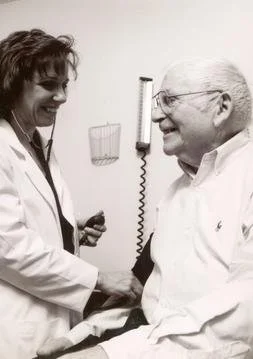
Elisabeth Rosenthal: Primary- care crisis intensifies
These measurements of health-care service levels for specific areas of the U.S. came out in June 2020 through the Health Resources and Services Administration (HRSA), an agency of the Department of Health and Human Services (HHS).
States in red have Rhode Island-based CVS’s Minute Clinics, which are cutting into traditional primary-care practices.
“We have a specialty-driven system. Primary care is seen as a thankless, undesirable backwater.”
— Michael L. Barnett, M.D., health-systems researcher and primary-care physician in the Harvard Medical School system
I’ve been receiving an escalating stream of panicked emails from people telling me their longtime physician was retiring, was no longer taking their insurance, or had gone concierge and would no longer see them unless they ponied up a hefty annual fee. They have said that they couldn’t find another primary-care doctor who could take them on or who offered a new-patient appointment sooner than months away.
Their individual stories reflect a larger reality: American physicians have been abandoning traditional primary- care practice — internal and family medicine — in large numbers. Those who remain are working fewer hours. And fewer medical students are choosing a field that once attracted some of the best and brightest because of its diagnostic challenges and the emotional gratification of deep relationships with patients.
The percentage of U.S. doctors in adult primary care has been declining for years and is now about 25 percent — a tipping point beyond which many Americans won’t be able to find a family doctor at all.
Already, more than 100 million Americans don’t have usual access to primary care, a number that has nearly doubled since 2014. One reason our coronavirus vaccination rates were low compared with those in countries such as China, France, and Japan could be because so many of us no longer regularly see a familiar doctor we trust.
Another telling statistic: In 1980, 62 percent of doctor’s visits for adults 65 and older were for primary care and 38 percent were for specialists, according to Michael L. Barnett, a health-systems researcher and primary- care doctor in the Harvard Medical School system. By 2013, that ratio had exactly flipped and has likely “only gotten worse,” he said, noting sadly: “We have a specialty-driven system. Primary care is seen as a thankless, undesirable backwater.” That’s “tragic,” in his words — studies show that a strong foundation of primary care yields better health outcomes overall, greater equity in health-care access, and lower per-capita health costs.
One explanation for the disappearing primary-care doctor is financial. The payment structure in the U.S. health system has long rewarded surgeries and procedures while shortchanging the diagnostic, prescriptive and preventive work that is the province of primary care. Furthermore, the traditionally independent doctors in this field have little power to negotiate sustainable payments with the mammoth insurers in the U.S. market.
Faced with this situation, many independent primary-care doctors have sold their practices to health systems or commercial management chains (some private-equity-owned) so that, today, three-quarters of doctors are now employees of those outfits.
One of them was Bob Morrow, who practiced for decades in the Bronx. For a typical visit, he was most recently paid about $80 if the patient had Medicare, with its fixed-fee schedule. Commercial insurers paid significantly less. He just wasn’t making enough to pay the bills, which included salaries of three employees, including a nurse practitioner. “I tried not to pay too much attention to money for four or five years — to keep my eye on my patients and not the bottom line,” he said by phone from his former office, as workers carted away old charts for shredding.
He finally gave up and sold his practice last year to a company that took over scheduling, billing and negotiations with insurers. It agreed to pay him a salary and to provide support staff as well as supplies and equipment.
The outcome: Calls to his office were routed to a call center overseas, and patients with questions or complaining of symptoms were often directed to a nearby urgent care center owned by the company — which is typically more expensive than an office visit. His office staff was replaced by a skeleton crew that didn’t include a nurse or skilled worker to take blood pressure or handle requests for prescription refills. He was booked with patients every eight to 10 minutes.
He discovered that the company was calling some patients and recommending expensive tests — such as vascular studies or an abdominal ultrasound — that he did not believe they needed.
He retired in January. “I couldn’t stand it,” he said. “It wasn’t how I was taught to practice.”
Of course, not every practice sale ends with such unhappy results, and some work out well.
But the dispirited feeling that drives doctors away from primary care has to do with far more than money. It’s a lack of respect for nonspecialists. It’s the rising pressure to see and bill more patients: Employed doctors often coordinate the care of as many as 2,000 people, many of whom have multiple problems.
And it’s the lack of assistance. Profitable centers such as orthopedic and gastroenterology clinics usually have a phalanx of support staff. Primary-care clinics run close to the bone.
“You are squeezed from all sides,” said Barnett.
Many ventures are rushing in to fill the primary-care gap. There had been hope that nurse practitioners and physician assistants might help fill some holes, but data shows that they, too, increasingly favor specialty practice. Meanwhile, urgent-care clinics are popping up like mushrooms. So are primary-care chains such as One Medical, now owned by Amazon. Dollar General, Walmart, Target, CVS Health and Walgreens have opened “retail clinics” in their stores.
Rapid-fire visits with a rotating cast of doctors, nurses, or physician assistants might be fine for a sprained ankle or strep throat. But they will not replace a physician who tells you to get preventive tests and keeps tabs on your blood pressure and cholesterol — the doctor who knows your health history and has the time to figure out whether the pain in your shoulder is from your basketball game, an aneurysm, or a clogged artery in your heart.
Some relatively simple solutions are available, if we care enough about supporting this foundational part of a good medical system. Hospitals and commercial groups could invest some of the money they earn by replacing hips and knees to support primary care staffing; giving these doctors more face time with their patients would be good for their customers’ health and loyalty if not (always) the bottom line.
Reimbursement for primary-care visits could be increased to reflect their value — perhaps by enacting a national primary care fee schedule, so these doctors won’t have to butt heads with insurers. And policymakers could consider forgiving the medical school debt of doctors who choose primary care as a profession.
They deserve support that allows them to do what they were trained to do: diagnosing, treating, and getting to know their patients.
The United States already ranks last among wealthy countries in certain health outcomes. The average life span in America is decreasing, even as it increases in many other countries. If we fail to address the primary care shortage, our country’s health will be even worse for it.
Elisabeth Rosenthal is a KFF Health News reporter.
Elisabeth Rosenthal: erosenthal@kff.org, @RosenthalHealth
Michelle Andrews: Don't get dropped by your doctor
Harvard Medical School quadrangle in Longwood Medical Area, Boston.
“Most primary care practices are incredibly busy, in part due to pent-up demand due to COVID. Even though continuity of care is important, if the patient hasn’t been in and we don’t know if they’re going to come in, it’s hard to leave space for them.’’
— Russell Phillips, M.D., director of Harvard Medical School’s Center for Primary Care and a general internist at Beth Israel Deaconess Medical Center, in Boston
When Claudia Siegel got a stomach bug earlier this year, she reached out to her primary care doctor to prescribe something to relieve her diarrhea. The Philadelphia resident was surprised when she received an online message informing her that because she hadn’t visited her doctor in more than three years, she was no longer a patient..
And since he wasn’t accepting new patients, she would have to find a new primary care physician.
“I think it’s unconscionable,” Siegel said, noting that many patients may have stayed away from the doctor’s office the past few years because of the covid pandemic. “There was no notification to patients that they’re on the verge of losing their doctor.”
Though it is dismaying to learn you’ve been dropped from a physician’s practice because a few years have passed since your last visit, the approach isn’t uncommon. Exactly how widespread the experience is, no one can say. But specialists also do this.
The argument for dropping the occasional patient makes some sense. Since many primary care doctors have a waiting list of prospective patients, removing those they rarely see opens up patient slots and improves access for others.
“Most primary care practices are incredibly busy, in part due to pent-up demand due to covid,” said Dr. Russell Phillips, director of Harvard Medical School’s Center for Primary Care and a general internist at Beth Israel Deaconess Medical Center.
“Even though continuity of care is important, if the patient hasn’t been in and we don’t know if they’re going to come in, it’s hard to leave space for them,” he said.
Patients often move away or find a different doctor when their insurance changes without notifying the practice, experts say. In addition, physicians may seek to classify people they haven’t seen in a long time as new patients since their medical, family, and social history may require a time-consuming update after a lengthy break. Patient status is one element that determines how much doctors get paid.
Still, the transition can be trying for patients.
“I can completely understand the patient’s perspective,” said Courtney Jones, a senior director of case management at the Patient Advocate Foundation. “You believe you have a medical team that you’ve trusted previously to help you make decisions, and now you have to find another trusted team.”
Siegel said she rarely went to the doctor, adhering to her physician father’s counsel that people shouldn’t go unless they’re sick. Although she hadn’t been to her doctor’s office in person recently, Siegel said she had corresponded with the practice staff, including keeping them up to date on her covid vaccination status.
After receiving the online dismissal through the patient portal for the Jefferson Health system, Siegel called the family medicine practice’s patient line directly. They told her three years was the protocol and they had to follow it.
“I asked, ‘What about the patient?’” Siegel said. “They didn’t have an answer for that.”
It was a month before Siegel, who has coverage under Medicare’s traditional fee-for-service program, could see a doctor who was accepting new patients. By that time, her stomach virus symptoms had resolved.
Jefferson Health doesn’t have a policy that patients lose their doctor if they’re not seen regularly, according to a statement from spokesperson Damien Woods.
However, he said, “Patients not seen by their provider for three years or more are classified in the electronic medical records as new patients (rather than established patients), per Center for Medicare and Medicaid Services (CMS) guidance. Whenever possible, Jefferson works with these patients to keep them with their primary care provider and offers options for new providers in certain circumstances.”
American Medical Association ethics guidelines recommend that physicians notify patients in advance when they’re withdrawing from a case so they have time to find another physician.
But the organization, which represents physicians, has no guidance about maintaining a panel of patients, said AMA spokesperson Robert Mills.
The American Academy of Family Physicians, which represents and advocates for family physicians, declined to comment for this story.
A primary care physician’s panel of patients typically includes those who have been seen in the past two years, said Phillips, of Harvard. Doctors may have 2,000 or more patients, studies show. Maintaining a workable number of patients is crucial, both for effective patient care and for the doctors.
“Practices realize that a major contributor to physician burnout is having more patients than you can deal with,” Phillips said.
Demand for physician services is expected to continue to outstrip supply in the coming decades, as people age and need more care at the same time the number of retiring physicians is on the upswing. According to projections from the Association of American Medical Colleges, by 2034 there will be a shortage of up to 48,000 primary care physicians.
Maintaining a regular relationship with a primary care provider can help people manage chronic conditions and promptly identify new issues. Regularly checking in also helps ensure people receive important routine services such as immunizations and blood pressure checks, said Dr. David Blumenthal, a former primary care physician who is president of the Commonwealth Fund, a research and policy organization.
Health care organizations increasingly focus on requiring doctors to meet certain quality metrics, such as managing patients’ high blood pressure or providing comprehensive diabetes care. In this environment, “it could be problematic for physicians to be accountable for the health of patients who do not see them,” Blumenthal said.
Money also figures into it. Steady visits are good for a practice’s bottom line. Practices may also decide to avoid new Medicare patients or those with certain types of insurance because the payments are too low, said Owen Dahl, a consultant with Medical Group Management Association, an organization for health care managers.
In general, doctors aren’t obligated to continue seeing a patient. A doctor might dismiss patients because they aren’t following clinical recommendations or routinely cancel or miss appointments. Belligerent or abusive behavior is also grounds for dropping a patient.
In certain instances, physicians may be legally liable for “patient abandonment,” a form of medical malpractice. State rules vary, but there are common elements. Those rules generally apply when a doctor harms a patient by dropping them abruptly at a critical stage of treatment. It would generally not apply if a patient has not seen the physician for several years.
Even though quietly dropping a seldom-seen patient might not have an immediate medical consequence, patients ought to be informed, experts said.
“It’s really good customer service to explain the situation,” said Rick Gundling, senior vice president at the Healthcare Financial Management Association, an organization for finance professionals. As for Siegel, he said, “This woman should not be left hanging. If you’re the patient, the physician should be proactive.”
Michelle Andrews is a Kaiser Health News journalist.




